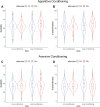Valenced tactile information is evoked by neutral visual cues following emotional learning
- PMID: 40800504
- PMCID: PMC12290739
- DOI: 10.1162/imag_a_00320
Valenced tactile information is evoked by neutral visual cues following emotional learning
Abstract
Learning which stimuli in our environment co-occur with painful or pleasurable events is critical for survival. Previous research has established the basic neural and behavioral mechanisms of aversive and appetitive conditioning; however, it is unclear precisely what information content is learned. Here we examined the degree to which aspects of the unconditioned stimulus (US)-sensory information versus affective salience-are transferred to the conditioned stimulus (CS). To decode what stimuli features (e.g., valence vs. discriminative somatosensation) are represented in patterns of brain activation elicited during appetitive (soft touch) and aversive (painful touch) conditioning to faces, a novel approach to using modeling with representational similarity analysis (RSA) based on theoretically driven representational patterns of interest (POIs) was applied to fMRI data. Once associations were learned through conditioning, globally, the CS reactivated US representational patterns showing conditioning-dependent reactivation in specific high-order brain regions: In the dorsal anterior cingulate cortex, the CS reactivated patterns associated with the affective salience of the US-suggesting that, with affective conditioning, these regions carry forward the affective associations of the experience.
Keywords: associative learning; conditioning; emotional learning; representational content; representational similarity analysis.
© 2024 The Authors. Published under a Creative Commons Attribution 4.0 International (CC BY 4.0) license.
Conflict of interest statement
The authors declare no competing financial interests.
Figures




References
-
- Choi , S. , Hachisuka , J. , Brett , M. A. , Magee , A. R. , Omori , Y. , Iqbal , N.-A. , Zhang , D. , DeLisle , M. M. , Wolfson , R. L. , Bai , L. , Santiago , C. , Gong , S. , Goulding , M. , Heintz , N. , Koerber , H. R. , Ross , S. E. , & Ginty , D. D. ( 2020. ). Parallel ascending spinal pathways for affective touch and pain . Nature , 587 ( 7833 ), 258 – 263 . 10.1038/s41586-020-2860-1 - DOI - PMC - PubMed
LinkOut - more resources
Full Text Sources
